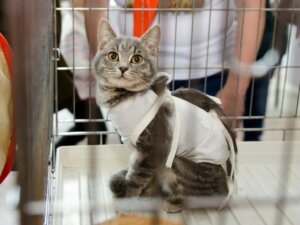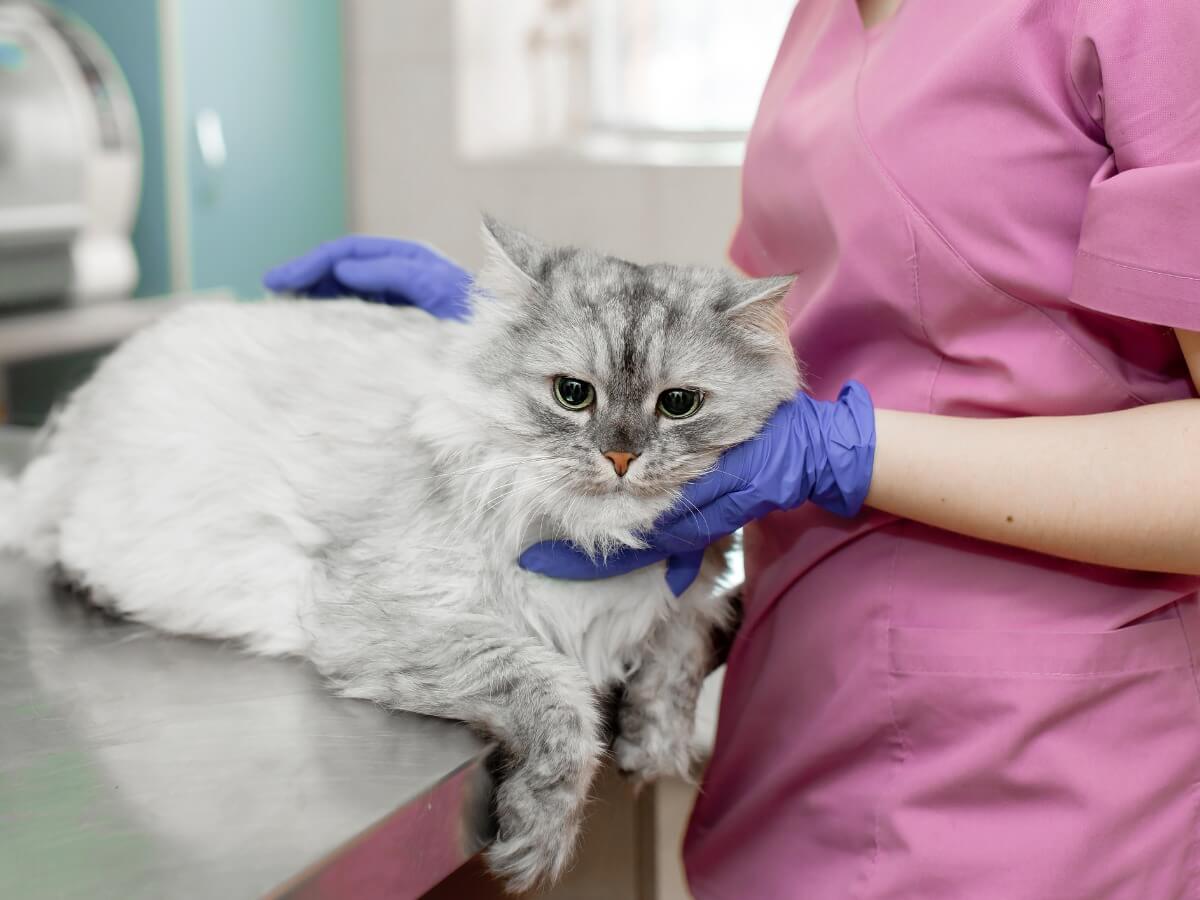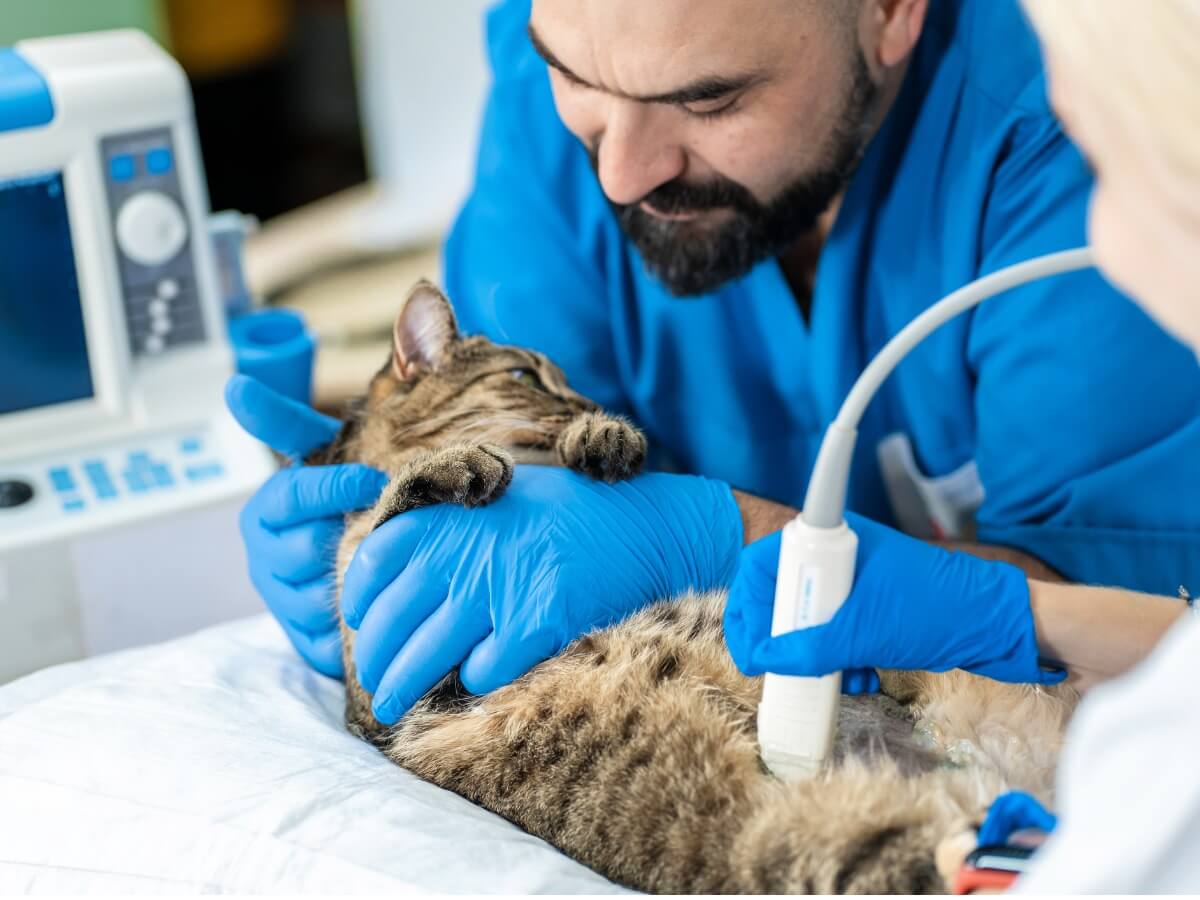Caring for a Sterilized Cat


Reviewed and approved by the biologist Samuel Sanchez
Caring for a newly sterilized cat is simple, although it also depends on the general health of each feline. In any case, veterinary professionals recommend carrying out specific and general care to look after them in the postoperative period. We’ll tell you what you need to do!
Remember that feline sterilization is a simple, daily, and common procedure, so the chances that it’ll put your pet’s life is at risk are very low. In fact, it’s quite the opposite. By sterilizing, you and your cat will benefit. You’ll stop contributing to overpopulation (by avoiding unwanted litters) and the cat won’t contract certain diseases or conditions.
What are the first days after sterilizing a cat like?
After sterilizing a cat, it’s normal for it to be weak, dizzy and even nauseous. The most advisable thing is to let the animal rest and overcome the symptoms associated with the effect of anesthesia. You’ll need to monitor it and always have it in your sight. You’ll be able to notice if it has bleeding, shortness of breath, pale gums, or fever. In this case, it’s essential to go to the emergency room.
Now, within the norm, according to a publication of the American Society for the Prevention of Cruelty to Animals (ASPCA), there are symptoms such as slight bleeding in the wound area, depression or “bad temper”, loss of appetite, vomiting, unsteadiness when walking, and chills. These are transitory and will begin to disappear with a few days.
It’s likely that your cat – or its companions, if it has any – will lick the wound that remains after the operation. In these cases, it is best to put an Elizabethan collar on the cat and separate it from the rest of the pets in the house.

General care of a sterilized cat
In addition to considering these symptoms, there are other care aspects for a neutered cat that you should know about. Among them are the following:
- Cat rest: After being sterilized, cats should avoid activities that require extra effort, such as jumping from or to very high places or rough play with other pets. The goal is to prevent internal bleeding or loosening of external stitches, if they have them.
- Bathing: It’s advisable not to bathe the cat while the recovery process continues, thus avoiding possible infections. You have to be very careful with bathing, especially if you take into account that cats move a lot during it, and this can hurt their wound.
- Treatment: The veterinarian or specialist will give you a specific guide to know how to help the healing process. They will also give you instructions on the appropriate disinfectant or product that won’t hurt the cat’s skin.
- Outdoor trips: Your cat’s adventures in open environments must be put on hold until approved by the veterinarian. The best thing to do is to visit the vet about 10 to 15 days after the intervention, to evaluate how the cat is getting on, and ask any questions you may have.
- Living with other animals: During the first two days, anesthesia can make the cat restless or in a bad mood, causing discomfort to those around it. If you notice they’re in a bad mood, it’s best to leave them alone in a room to itself.
Feeding freshly spayed cats
With a sterilized cat, you also have to manage its feeding. During the first and second days after surgery, it’s normal for the feline to lose its appetite, or even to vomit after eating its usual food. If the cat goes many days without eating and doesn’t even react to its favorite dish, then it’s better to consult with the veterinarian.
Experts point out that sterilized cats voluntarily increase their food intake by 20%. That’s why it’s a good idea to monitor its diet and always offer the most balanced options. This extra weight can, in some cases, cause obesity.
To prevent this, there are some recommendations that you can ask your vet. Although the most common thing is to reduce the portions that were given before the procedure, this isn’t recommended. The reason here is that an imbalance in their metabolism can occur and this can trigger problems or deficiencies of vitamins, minerals or proteins.
The professional will be able to recommend a change of feed for a more complete one specialized in sterilized cats. They could also suggest that you purchase an interactive plate that will slow the pet down, among other options.
Peace of mind for newly spayed cats
The peace of mind that you provide to your newly sterilized cat is also part of this essential care. The pet must be in an environment in which they’ll be able to recover physically, and one which adapts to the changes that they’ll begin to experience.
The first days are better spent in a dark room or area, as their pupils will be very sensitive because of the anesthesia. We also recommend that you avoid exposing it to loud noises or sounds that may prevent it from resting. Little by little, the cat will leave this area and recover its daily life.

Keep in mind that, from the first moment a cat is sterilized, hormonal changes, and therefore behavioral changes, will begin to be noticed. This is the greatest benefit that cats acquire from being sterilized and many even leave behind practices such as improper marking of territory. In fact, some owners claim that their feline friends become more affectionate and calm!
Caring for a newly sterilized cat is simple, although it also depends on the general health of each feline. In any case, veterinary professionals recommend carrying out specific and general care to look after them in the postoperative period. We’ll tell you what you need to do!
Remember that feline sterilization is a simple, daily, and common procedure, so the chances that it’ll put your pet’s life is at risk are very low. In fact, it’s quite the opposite. By sterilizing, you and your cat will benefit. You’ll stop contributing to overpopulation (by avoiding unwanted litters) and the cat won’t contract certain diseases or conditions.
What are the first days after sterilizing a cat like?
After sterilizing a cat, it’s normal for it to be weak, dizzy and even nauseous. The most advisable thing is to let the animal rest and overcome the symptoms associated with the effect of anesthesia. You’ll need to monitor it and always have it in your sight. You’ll be able to notice if it has bleeding, shortness of breath, pale gums, or fever. In this case, it’s essential to go to the emergency room.
Now, within the norm, according to a publication of the American Society for the Prevention of Cruelty to Animals (ASPCA), there are symptoms such as slight bleeding in the wound area, depression or “bad temper”, loss of appetite, vomiting, unsteadiness when walking, and chills. These are transitory and will begin to disappear with a few days.
It’s likely that your cat – or its companions, if it has any – will lick the wound that remains after the operation. In these cases, it is best to put an Elizabethan collar on the cat and separate it from the rest of the pets in the house.

General care of a sterilized cat
In addition to considering these symptoms, there are other care aspects for a neutered cat that you should know about. Among them are the following:
- Cat rest: After being sterilized, cats should avoid activities that require extra effort, such as jumping from or to very high places or rough play with other pets. The goal is to prevent internal bleeding or loosening of external stitches, if they have them.
- Bathing: It’s advisable not to bathe the cat while the recovery process continues, thus avoiding possible infections. You have to be very careful with bathing, especially if you take into account that cats move a lot during it, and this can hurt their wound.
- Treatment: The veterinarian or specialist will give you a specific guide to know how to help the healing process. They will also give you instructions on the appropriate disinfectant or product that won’t hurt the cat’s skin.
- Outdoor trips: Your cat’s adventures in open environments must be put on hold until approved by the veterinarian. The best thing to do is to visit the vet about 10 to 15 days after the intervention, to evaluate how the cat is getting on, and ask any questions you may have.
- Living with other animals: During the first two days, anesthesia can make the cat restless or in a bad mood, causing discomfort to those around it. If you notice they’re in a bad mood, it’s best to leave them alone in a room to itself.
Feeding freshly spayed cats
With a sterilized cat, you also have to manage its feeding. During the first and second days after surgery, it’s normal for the feline to lose its appetite, or even to vomit after eating its usual food. If the cat goes many days without eating and doesn’t even react to its favorite dish, then it’s better to consult with the veterinarian.
Experts point out that sterilized cats voluntarily increase their food intake by 20%. That’s why it’s a good idea to monitor its diet and always offer the most balanced options. This extra weight can, in some cases, cause obesity.
To prevent this, there are some recommendations that you can ask your vet. Although the most common thing is to reduce the portions that were given before the procedure, this isn’t recommended. The reason here is that an imbalance in their metabolism can occur and this can trigger problems or deficiencies of vitamins, minerals or proteins.
The professional will be able to recommend a change of feed for a more complete one specialized in sterilized cats. They could also suggest that you purchase an interactive plate that will slow the pet down, among other options.
Peace of mind for newly spayed cats
The peace of mind that you provide to your newly sterilized cat is also part of this essential care. The pet must be in an environment in which they’ll be able to recover physically, and one which adapts to the changes that they’ll begin to experience.
The first days are better spent in a dark room or area, as their pupils will be very sensitive because of the anesthesia. We also recommend that you avoid exposing it to loud noises or sounds that may prevent it from resting. Little by little, the cat will leave this area and recover its daily life.

Keep in mind that, from the first moment a cat is sterilized, hormonal changes, and therefore behavioral changes, will begin to be noticed. This is the greatest benefit that cats acquire from being sterilized and many even leave behind practices such as improper marking of territory. In fact, some owners claim that their feline friends become more affectionate and calm!
All cited sources were thoroughly reviewed by our team to ensure their quality, reliability, currency, and validity. The bibliography of this article was considered reliable and of academic or scientific accuracy.
- Uribe Sarmiento, F. F., Prada Delgado, Y. F., Rodríguez Barajas, B. S., & Bayona Sánchez, J. A. (2018). Métodos de esterilización en caninos y felinos; revisión de literatura (Doctoral dissertation, Universidad Cooperativa de Colombia, Facultad de Ciencias de la Salud, Medicina Veterinaría y Zootecnia, Bucaramanga).
- Baciero, G. (2015). La alimentación después de la esterilización.
- Jeusette, I., & Romano, V. (2000). Gatos esterilizados. Research reports, 1-4.
- Aisabucha Baldeón, G. D. R., & Muñoz Delgado, P. M. (2011). Campaña de esterilización para erradicar la sobrepoblación canina y felina en barrios marginales del sur de Guayaquil a través de la fundación FADA (Bachelor’s thesis, Guayaquil: ULVR, 2011.).
- Post, C., Para, O., & Perro, S. (2021). Cuidados Post Operatorios Para Su Perro. American Society for the Prevention of Cruelty to Animals (ASPCA).
This text is provided for informational purposes only and does not replace consultation with a professional. If in doubt, consult your specialist.








